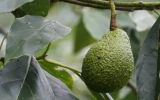17 Most Common Fruit Trees Types (With Pictures)
Fruit trees are not just sources of delicious snacks; they're also integral to ecosystems around the world. In this guide, we'll explore the 17 most common types of fruit trees, complete with vivid pictures to help you identify and appreciate each variety.
The most common fruit tree types include the following:
- Apple
- Orange
- Banana
- Mango
- Peach
- Pear
- Cherry
- Plum
- Lemon
- Lime
- Fig
- Pomegranate
- Avocado
- Papaya
- Apricot
- Grapefruit
- Coconut
From apples to oranges, every tree is not just about tasty fruits but also about surprising secrets and interesting backgrounds. Let's dive in and discover the unexpected tales behind these everyday trees!
Summary
- Many popular fruit trees like apple, peach, pear, plum, and cherry come from the genus Prunus, a native of Europe and Asia, which produces stone fruits with soft, juicy flesh.
- Citrus fruits like orange, lemon, lime, and grapefruit originate from tropical and subtropical regions like China, Asia, and the Caribbean.
- Tropical fruits like banana, mango, papaya, coconut, and avocado come from hot and humid climates in Mexico, Central/South America, India, and Southeast Asia, all of which have softer, starchier flesh compared to other fruits.
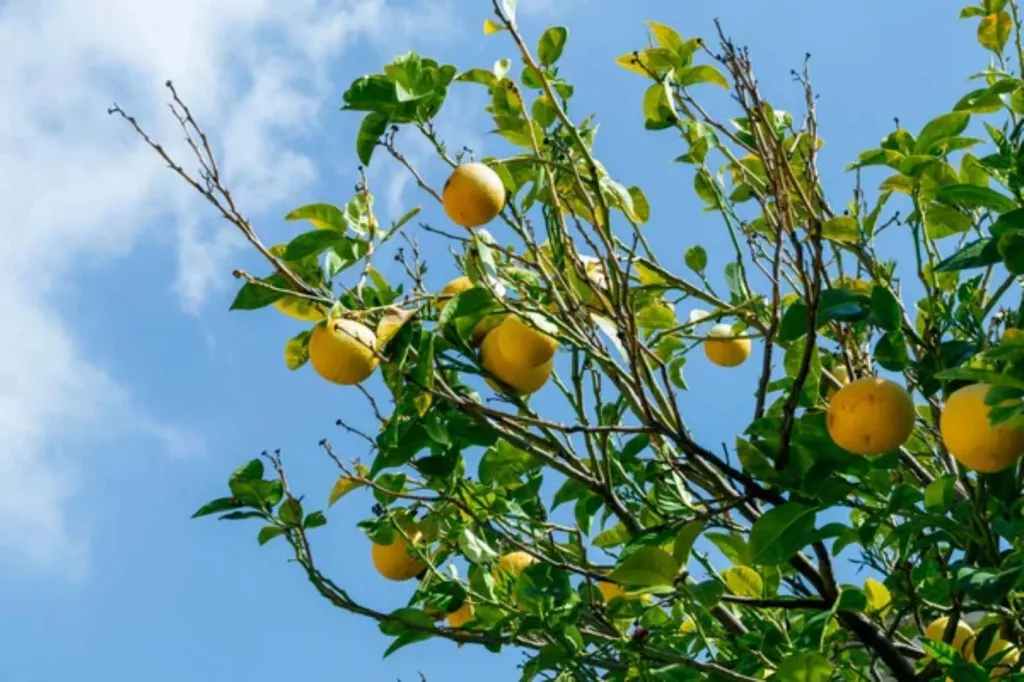
On this page:
Most Common Fruit Tree Types
| Fruit Tree Type | Genus/Species | Origin | Key Characteristics |
|---|---|---|---|
| Apple | Malus | Central Asia | Juicy, sweet-tart flavor, many cultivars |
| Orange | Citrus sinensis | China | Juicy segments, high in vitamin C |
| Banana | Musa | Southeast Asia | Starchy, sweet, seedless |
| Mango | Mangifera | India, Southeast Asia | Sweet, juicy flesh, large pit |
| Peach | Prunus persica | China | Soft, juicy flesh, fuzzy skin |
| Pear | Pyrus | Europe, Asia | Juicy, crisp flesh, tapered shape |
| Cherry | Prunus | Europe, Asia | Small, sweet, smooth skin |
| Plum | Prunus domestica | Europe, Asia | Juicy, smooth skin, stone fruit |
| Lemon | Citrus limon | Asia | Tart, juicy, high in vitamin C |
| Lime | Citrus aurantiifolia | Southeast Asia | Tart, juicy, green flesh |
| Fig | Ficus carica | Middle East, Asia | Soft, sweet flesh, tiny seeds |
| Pomegranate | Punica granatum | Iran, India | Juicy arils, tart flavor |
| Avocado | Persea americana | Mexico | Creamy texture, high fat |
| Papaya | Carica papaya | Mexico, Central America | Soft, sweet, orange flesh |
| Apricot | Prunus armeniaca | China | Smooth skin, sweet flesh, stone fruit |
| Grapefruit | Citrus paradisi | Barbados | Tart, juicy segments, pink/yellow flesh |
| Coconut | Cocos nucifera | Southeast Asia, Pacific | Hard shell, meaty white flesh, watery liquid |
Apple trees are diverse
Genus: Malus spp.
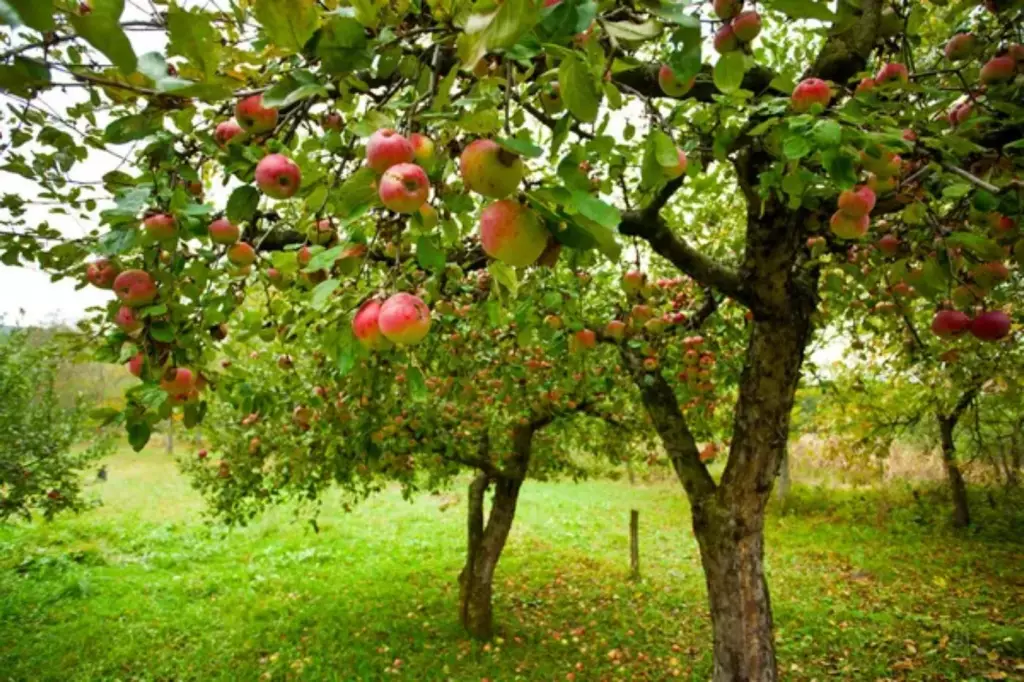
Apple trees are classic trees not only known for their delicious and juicy fruits but also for their beautiful springtime flowers. The common apple tree (Malus domestica) requires full sunlight and thrives in hardiness zones 3 to 8.
The Granny Smith apple variety is famed for its tangy flavor and firm texture, great in both fresh consumption and baking. These trees can grow to a considerable size, often up to 20 feet tall, providing ample shade with their lush leaves.
To care for your apple tree, ensure it gets at least 6 hours of sunlight daily. The soil should be well-draining, and you'll want to offer regular watering, especially as it's growing.
If you have an acre of land, you can plant at least 36 standard apple trees, and 400 trees for dwarf apple varieties.
| Variety | Attributes |
|---|---|
| Granny Smith | Tart, green skin, firm |
| McIntosh | Reddish-green, tender, mildly tart |
| Fuji | Sweet, crispy, long shelf life |
| Gala | Sweet, yellow-orange with red stripes, aromatic |
These trees generally have a rough, grey bark, and they produce white to pink flowers in the spring. Whether you're growing for your table or as a hobby, apples provide a delightful experience both in care and harvest.
Orange trees can be a bountiful source of sweetness and nutrition
Species name: Citrus sinensis

Orange trees are beloved for their vibrant and juicy fruits, rich in vitamin C. They belong to the genus Citrus, making them a staple among citrus trees. These trees typically produce sweet oranges, known for their bright orange skin and delectable taste.
When you're planting orange trees, you'll want to choose a spot in hardiness zones 9 to 11. They thrive in these warm climates and offer a lush aesthetic, with glossy green leaves and fragrant white flowers.
The fruit themselves are hesperidia, a type of berry with a leathery rind and segmented flesh packed with seeds. Citrus fruits like oranges are considered one of the most lucrative orchard crops, with a profit potential of $5,000 up to $10,000 per acre.
Bananas are one of the most familiar fruit trees in tropical regions
Genus: Musa
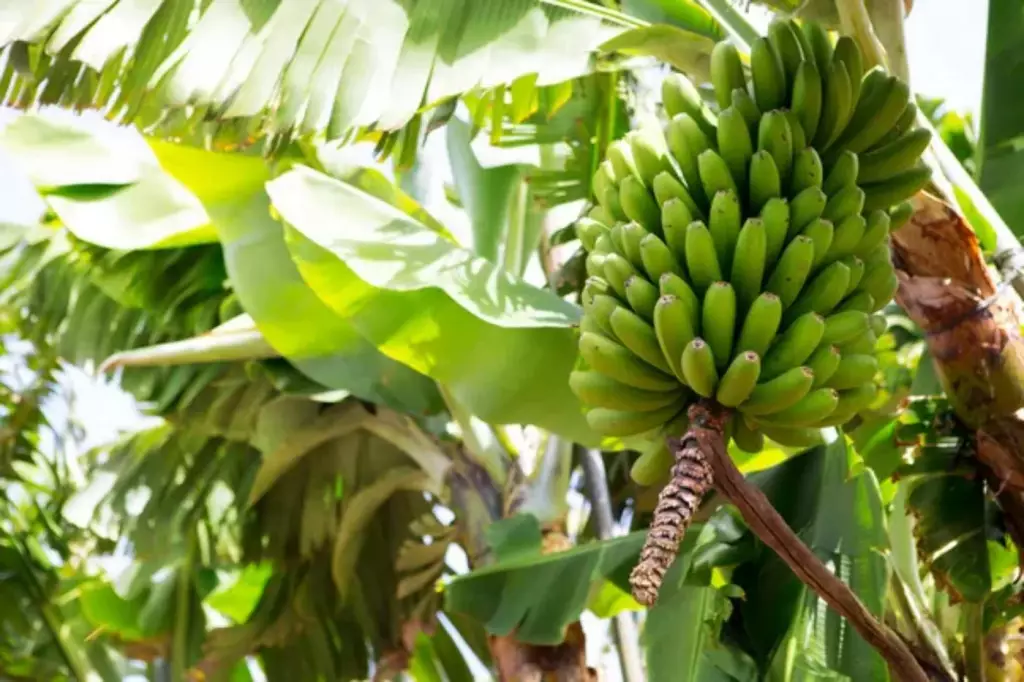
Bananas aren't trees, but rather large herbaceous plants. The fruit comes from the Musa genus and thrives in places with warm temperatures and gentle shade.
Banana plants are recognized by their large leaves, which unfurl from the top, creating a canopy that can provide shade. These leaves can suffer in strong winds, so a sheltered spot is ideal for growth.
Depending on the variety, bananas can vary in size and color, from small and sweet "finger" bananas to larger plantain types.
Here are some quick facts to guide you:
- Climate: Prefers tropical or subtropical, hardiness zones 9-11
- Size: Can reach heights of 2 to 9 meters (6 to 30 feet), depending on the species
- Fruit: Varies in size, typically elongated and curved with soft and starchy flesh
- Growth needs: Moist, well-drained soil; regular watering and fertilizer
Mango trees prefer a warm climate
Genus: Mangifera

Mango trees are renowned for their juicy, sweet fruits, which are rich in vitamins like vitamin C and A. These trees thrive in tropical regions due to their preference for a warm climate.
Appearance: Mango trees have deep green, glossy leaves and can grow quite large, providing ample shade.
Fruit: The fruit varies in size and color, often with shades of yellow, orange, or red when ripe.
When growing a mango tree, consider the following:
| Hardiness Zone | Sun Exposure | Soil Type |
|---|---|---|
| Zone 10-11 | Full sun | Well-draining soil |
Your mango tree will bloom with small, fragrant flowers before fruiting. The seeds inside the fruit can also be used to propagate new trees.
Peach trees provide both tasty fruit and lovely blooms
Species name: Prunus persica

The round, juicy peaches boast velvety skin and come in shades from yellow to red. In spring, your peach tree’s branches will be adorned with pink and white flowers.
These stone fruits are perfect for a fresh snack or as part of a dessert. Don’t confuse peaches with nectarines, though; nectarines are similar but have smooth skin. Peach trees can grow quite large, offering shade on sunny days.
For growing peach trees, you need well-drained soil and plenty of sunshine. They thrive in temperate regions and are commonly grown in states like Georgia and South Carolina.
| Peach Tree Size | Fruit Type |
|---|---|
| Standard | Clingstone and freestone |
| Dwarf | Freestone |
| Semi-dwarf | Clingstone and freestone |
Choose a variety that suits your space and climate best. With the right care, your peach tree can be both an attractive and delicious addition to your garden. It can also be a lucrative addition to your garden.
Pear trees are delightful additions to your garden
Genus: Pyrus
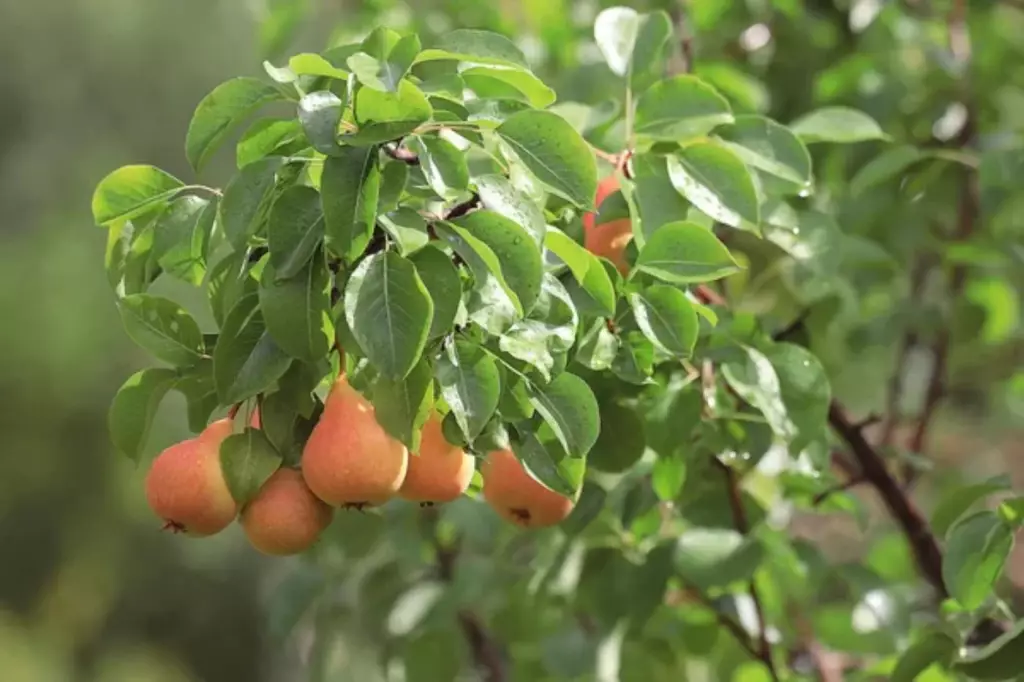
They provide not only juicy fruits but also beautiful spring flowers. As members of the pome fruit family, pears offer a sweet treat right from the branches or can be enjoyed fresh from your kitchen.
Appearance and fruit:
- Leaves: Pear trees showcase glossy green leaves through the growing season.
- Flowers: In spring, you'll see delicate white or pink flowers adorning the branches.
- Fruit: The fruits range in color from green to yellow and sometimes have a red blush.
Growing needs:
- Hardiness zones: These trees grow best in hardiness zones 4 through 9.
- Soil: They need well-draining soil and full sun to partial shade.
- Watering: Regular watering helps to establish a strong root system.
Common varieties:
- The Bartlett pear is aromatic and perfect for eating fresh.
- The Kieffer pear, a mix of Asian Pear and Bartlett, is hardy and self-fruitful.
- The Anjou pear is well-loved in the USA for its sweet flavor.
Cherry trees are beloved for their delicious stone fruits and stunning flowers
Genus: Prunus
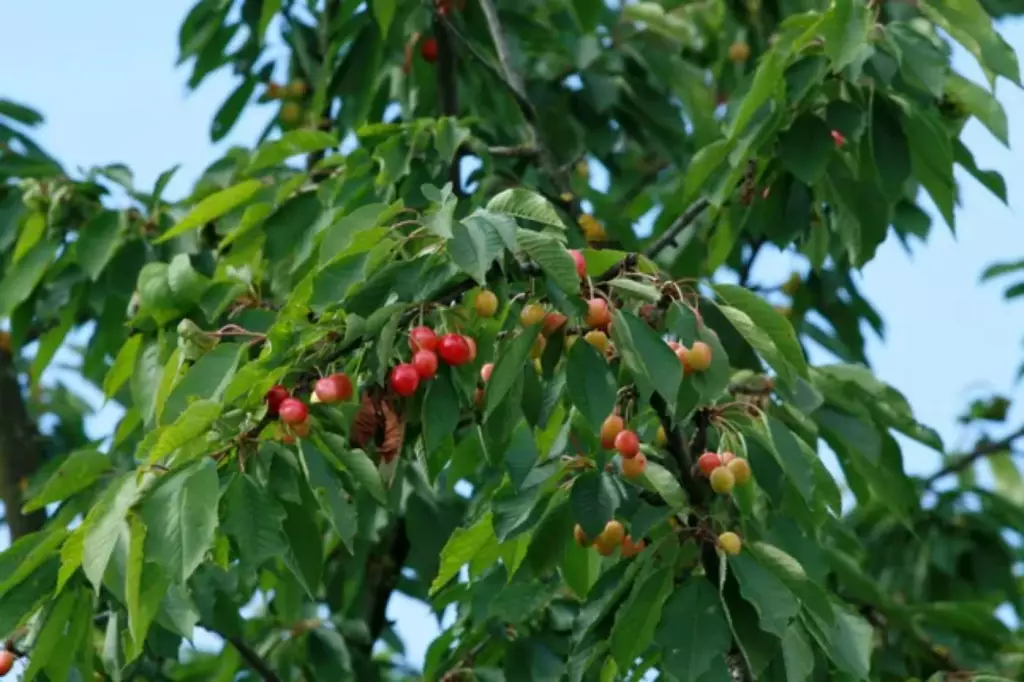
Sweet cherries produce large, juicy berries often eaten fresh or used in desserts; while some varieties are perfect for making jam. Recognizable by their beautiful blossoms, cherry trees are a popular choice in many gardens.
Basic features of cherry trees
- Fruit: Ranges from sweet to tart
- Flowers: White to light pink
- Leaves: Green and oval-shaped
Common growing locations for cherry trees
Grown in hardiness zones 4 through 9, cherry trees thrive across many regions.
Growing needs of cherry trees
- Sunlight: Full sun is best to ensure healthy growth and abundant fruiting.
- Soil: Prefers well-drained, fertile soil.
- Shade: While they need sun, young trees may require protection from harsh afternoon light.
To learn more about the different types of cherry trees, you should visit this article.
Plum trees are another good addition to a garden
Species name: Prunus domestica

Plum trees will not only provide you with shade but will also treat you to the juicy and sweet flavors of its fruits. Plums are stone fruits, which means they have a hard pit, or "stone," within their center.
When you choose a plum tree, you're selecting a plant that can flourish in a variety of hardiness zones, generally between zones 4 and 9. Most plum trees need full sun to produce the best fruit, so pick a sunny spot for planting.
Varieties of plum trees
- European plums: Often enjoyed fresh, these have an oval shape with rich flavor.
- Japanese plums: These are rounder, typically larger, and perfect for making jellies and jams.
- Cherry plum: Smaller in size and great for snacking right off the branch.
Key attributes of plum trees
- Flowers: Beautiful blooms that herald the arrival of spring.
- Fruit: Typically produced in summer, they offer a myriad of culinary uses.
- Hardiness: Adaptable to many climates but some varieties may need winter chill.
Growing needs of plum trees
- Sunlight: At least six hours of direct sunlight daily.
- Soil: Well-drained soil with medium fertility.
- Water: Regular watering, more during dry spells to ensure sweet fruit production.
Lemon trees also add a fresh scent to your garden
Species name: Citrus limon

Lemon trees are a delightful addition to your garden, not only providing fruit but also adding a fresh scent. These citrus trees can offer you abundant vitamin C-rich lemons almost year-round.
Varieties of lemon trees
- Eureka: Common in supermarkets, thrives in hot climates, lacks cold hardiness.
- Verna: Grows well in Spain, reaches up to 20 feet, not widely grown commercially in the U.S.
Benefits and uses lemon trees
The lemon fruit is versatile, used in everything from cooking to cleaning. You can enjoy them fresh, squeeze them for lemonade, or incorporate them into jams.
Growing needs of lemon trees
- Prefer hardiness zones 9-10.
- Require full sun for best fruit production.
- Need well-draining soil.
Lemon tree features
- Can provide shade with their evergreen leaves.
- Fragrant white flowers can attract pollinators to your garden.
Limes are a versatile choice for any home garden
Genus: Citrus
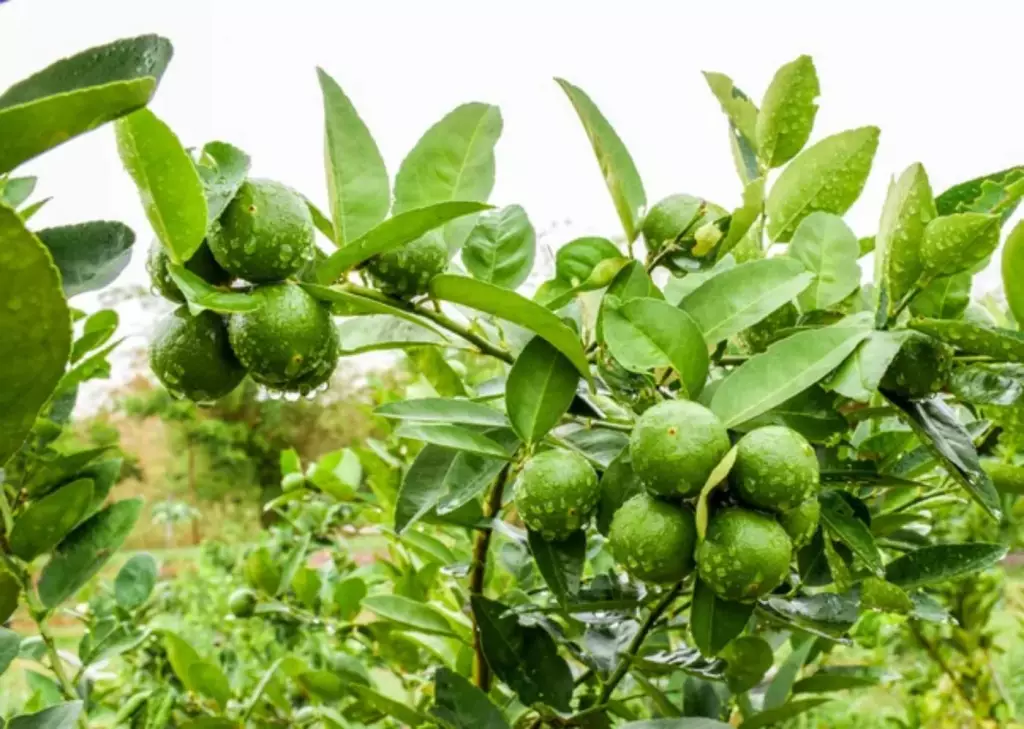
Limes are vibrant citrus fruits, popular for their tart flavor and high vitamin C content. Your average lime is a green, round, and juicy fruit, which turns yellow as it reaches full ripeness.
Lime trees are adorned with white flowers and glossy leaves, adding aesthetic value to your garden.
| Variety | Scientific name | Appearance | Benefits | Growth |
|---|---|---|---|---|
| Key lime | Citrus aurantifolia | Small, round fruits with a strong, acidic taste. | Rich in vitamin C, aids digestion. | Thrives in warmer climates, hardiness zones 9-11. |
| Persian lime | Citrus latifolia | Larger than Key limes, seedless, with a mild flavor. | Less acidic, easy to juice. | Commonly grown in commercial orchards, adaptable to various soils. |
| Kaffir lime | Citrus hystrix | Distinctive bumpy skin, with a strong lime scent. | Leaves used in cooking for their aroma. | Prefers tropical climates, zones 9-10. |
| Rangpur lime | Citrus limonia | Hybrid with a mandarin orange, reddish-orange when ripe. | Tangy flavor, used in beverages and marmalades. | Can tolerate a wider range of soil types, suited for zones 8-11. |
When cultivating lime trees, ensure you provide ample sunlight and protect them from cold temperatures. They prefer well-draining soil and moderate watering.
If cared for, lime trees can offer shade, delightful flowers, and plentiful fruit. Whether you're making a zesty limeade or garnishing a dish, limes are a versatile choice for any home garden.
Fig trees are loved for their attractive foliage
Species name: Ficus carica
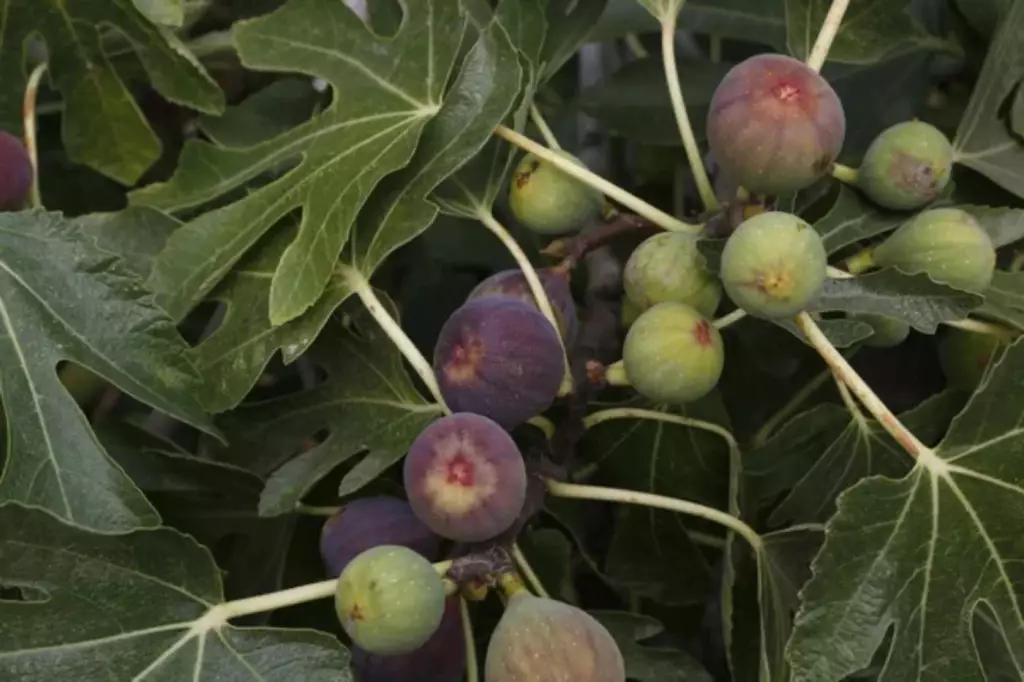
The leaves of fig trees are large and deeply lobed, providing a tropical look and pleasant shade. In spring, your tree will produce small flowers that are not outwardly visible, as they bloom inside the figs themselves.
These unique trees are self-fertile, so you don't need more than one to get fruit.
Here's a quick guide to what you should know about growing fig trees:
| Hardiness Zones | Fruit Appearance | Size | Benefits |
|---|---|---|---|
| 6-11 | Medium to large, variable color from yellow to dark purple | 10-30 feet tall depending on the variety | Eat fresh, use in jams, attractive foliage |
You'll find figs thrive well in hardiness zones 6-11, making them versatile in both cool and warm areas. Just ensure they get about 100-200 chill hours for proper dormancy. If you're in a particularly cold region, consider the 'Chicago Hardy' variety as it's known for cold resistance.
Your fig tree will prefer a sunny spot with well-draining soil to produce the best fruit. Regular watering helps, especially as the fruit ripens.
With good care, you can enjoy fresh figs directly from your tree and the joy of serving homemade fig jams from your very own harvest.
Pomegranate can add beauty to your garden
Species name: Punica granatum
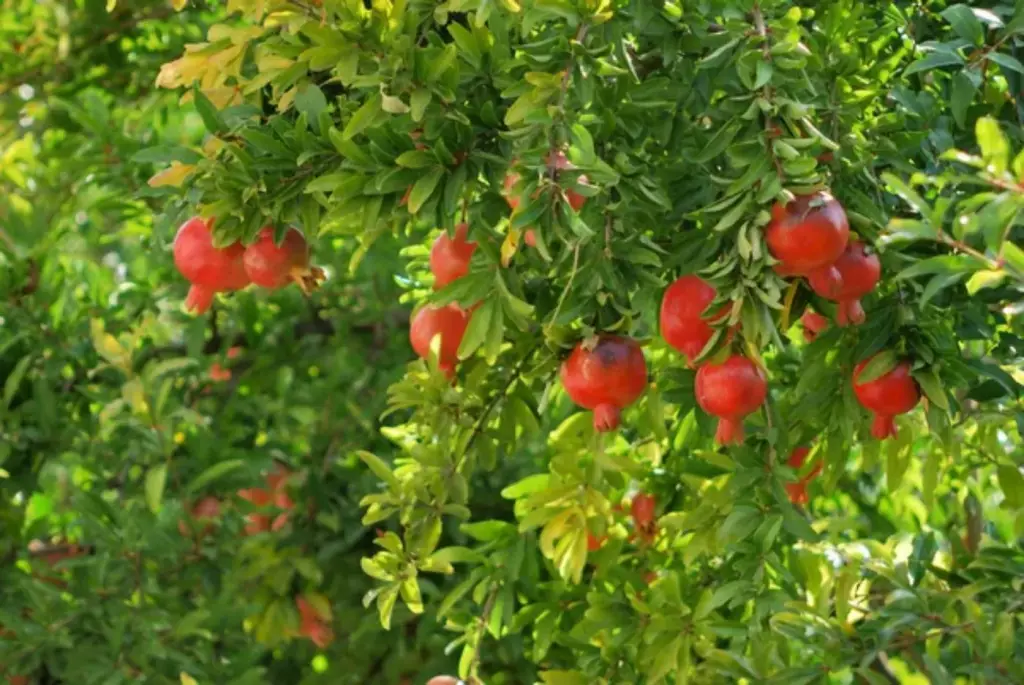
The pomegranate tree is known for its beautiful flowers and juicy fruits, filled with delicious seeds packed with antioxidants and vitamins. This fruit tree will offer you not only fresh produce but also ornamental beauty, thanks to its vibrant red flowers.
- Appearance: Pomegranates are characterized by their glossy, leathery skin that houses clusters of juicy, gem-like seeds.
- Flavor: The arils (seeds) are both sweet and tart, making the fruit refreshingly complex.
Pomegranate trees thrive in hardiness zones 8-10, requiring full sun to produce the best fruit. They can adapt to different soil types but need well-draining conditions.
Benefits:
- Rich in antioxidants: Helps protect your cells from damage.
- High vitamin content: Includes vitamins C, K, and folate.
Growing tips:
- Plant in a location that receives at least six hours of direct sunlight.
- Ensure the soil is well-drained to prevent root rot.
Your pomegranate tree will enjoy a sunny spot in your garden and can tolerate some shade, but too much might reduce fruiting. With proper care, you will have both a decorative and productive tree in your garden.
Avocado trees are evergreens that produce rich creamy fruits
Species name: Persea americana
Avocado trees are evergreens with rich, creamy fruits that you often find in salads, on toast, or blended into smoothies. These trees, originating from tropical regions, can enhance your garden with their lush, green foliage and provide you with fresh avocados loaded with vitamins and protein.
The trees generally require a hardiness zone of 9 to 11, as they thrive in warm climates. You can learn more about the ideal climate for avocado trees in this article.
They demand well-drained soil and plenty of sunlight but will also need some shade from intense afternoon heat.
| Variety | Height | Fruit Size |
|---|---|---|
| Dwarf | Up to 25 feet | Small |
| Semi-Dwarf | Up to 30 feet | Larger than dwarf |
| Standard | Up to 40 feet | Varies |
| Tall | Up to 60 feet | Varies |
Each tree produces unique flowers which contribute to the pollination process. The Hass avocado, for instance, is quite popular and recognized for its pebbly skin and consistent-quality fruit.
If you're looking for something smaller, the Wurtz or "Little Cado" is the only true dwarf avocado, fitting nicely in smaller yards.
Papayas are common tropical fruit tree
Scientific name: Carica papaya

Papayas are tropical fruit trees with large lobed leaves that create a dramatic silhouette against your garden sky. You'll appreciate their single trunk topped by a spread of foliage that may stretch up to 5 or 6 meters high.
Within these treetops, you'll find hermaphrodite flowers, which can self-pollinate, ensuring a bountiful fruit harvest without the need for a separate male tree.
The fruits themselves are oval and can be quite large, reaching several pounds in weight. Their flesh is juicy and comes in shades of orange to rose, depending on the variety, with a wealth of vitamins, particularly vitamin C, contributing to their health benefits.
If you're looking to grow papaya, remember it thrives in hardiness zones 9 to 11 and requires plenty of sunlight and well-draining soil.
When you're in tropical regions, you'll notice papayas are commonly cultivated and enjoyed fresh, straight from the tree. Their pleasant sweetness is not only delicious but also packs a punch of hydration.
Remember, in cooler climates, you can still enjoy growing papaya by using a greenhouse or indoor setup. However, manage your expectations regarding fruit size and quantity. Your patience and care will be rewarded with this luscious tropical delicacy!
Apricot trees produce charming spring blossoms
Scientific name: Prunus armeniaca

Apricot trees offer not just delicious fruit but also the charm of spring blossoms that can provide a lovely shade in your garden. When you plant apricot trees, you're choosing a tree that delivers both sweet apricots and a scenic view.
Characteristics of apricots
- Fruit: Apricots are small, juicy stone fruits.
- Flavor: They're often eaten fresh or used in jams due to their sweetness.
- Flowers: Delicate white or pink flowers bloom in early spring.
Apricot trees thrive in hardiness zones 4-9, depending on the variety. They require full sun and well-drained soil. These trees typically grow 15-25 feet tall.
Some popular apricot varieties include the Apache, which is a newer variant known for its freestone quality, making it easy to eat. Then there's the Tilton apricot, celebrated for its pink blossoms and delightful fruit.
Grapefruit is another citrus tree
Species name: Citrus paradisi
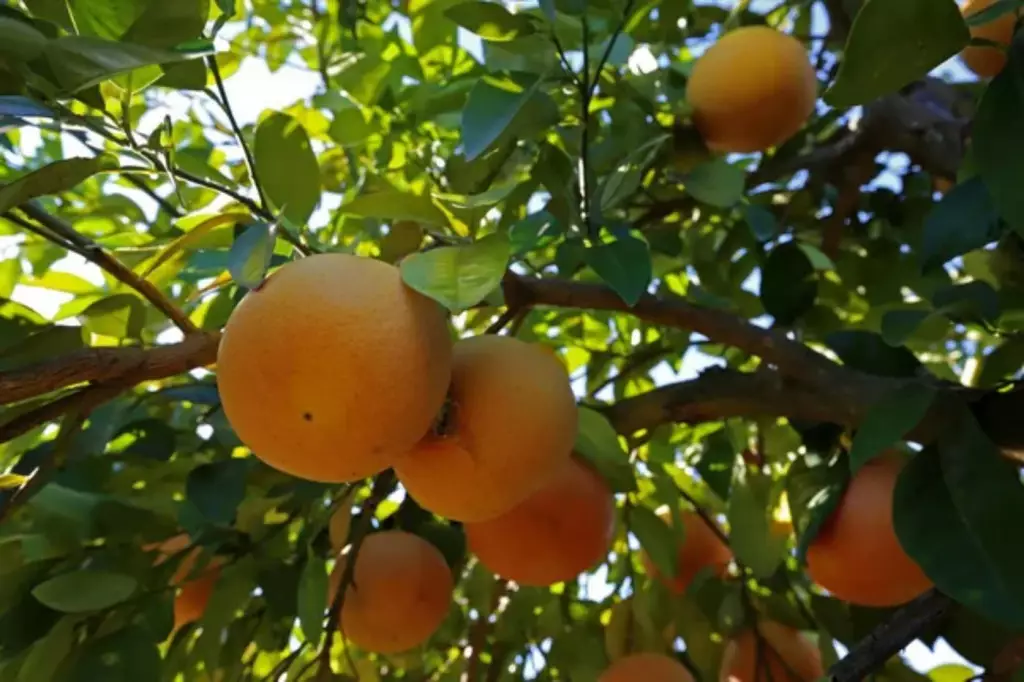
Grapefruit trees are known for their large, glossy green leaves and fragrant white flowers. When these trees bloom, they offer not only a fresh citrus scent but also the promise of the juicy fruit they'll later bear.
A mature grapefruit tree can produce a generous amount of fruit annually. The grapefruit itself is a citrus fruit with a notably bitter and semi-sweet taste.
It's rich in vitamins, particularly vitamin C, making it a healthy choice for a morning juice or a fresh snack. They come in a variety of colors, from the common yellow-skinned to ones with pink and red hues inside.
Here's a quick guide to their growing needs:
- Hardiness zones: Grapefruit trees thrive in USDA zones 9 to 11.
- Sunlight: They prefer full sun but can tolerate some shade.
- Soil: Well-draining soil is essential for healthy roots.
If your climate is cooler, you can still enjoy growing grapefruit by keeping the tree in a large container and ensuring it is well-pruned; this allows for easier movement indoors during cold spells.
In places where they're commonly grown, like Florida and California, grapefruit trees can be a handsome addition to your garden, provided they get enough sun and are protected from frost.
Coconuts are a staple of tropical regions
Species name: Cocos nucifera
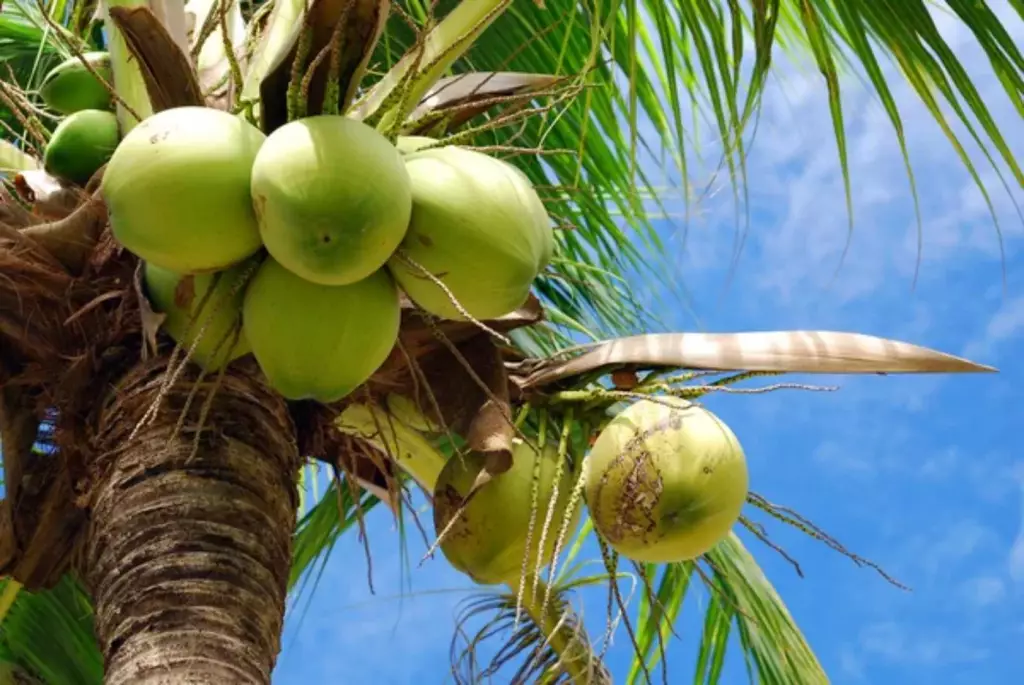
These trees grow on large palm trees with extensive, large leaves that provide a quaint shade. These trees are not only known for their nuts but also for the versatility of the fruits they bear.
The coconut has a thick fibrous husk encasing a nut with rich, nutritious water inside. As the nut matures, the water gives way to the white, fleshy coconut meat.
This fruit is cherished for its fresh taste and multitude of uses in food, drink, and industrial products.
Here's a snapshot of coconut tree characteristics:
| Characteristic | Description |
|---|---|
| Size | Tall, can reach up to 30m in height |
| Leaf size | Can be up to 6m long |
| Fruit type | Large drupe (nut) |
| Hardiness zone | Generally 10 to 12 |
Coconut palms thrive in well-drained soil and require regular sunlight, making them a perfect fit for your sunny garden if you live in a warmer climate. They also demand consistent moisture, but be wary of overwatering, as this can be detrimental to their roots.
Commonly found in regions like Indonesia and the Caribbean, these trees need minimum temperatures above freezing, so they are restricted to hardiness zone 10 and upwards.
Planting your coconut tree in a spot where it gets ample sunlight is key; you'll be supporting its growth and enjoying the tropical ambiance it brings.


